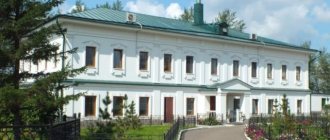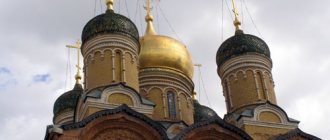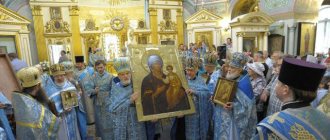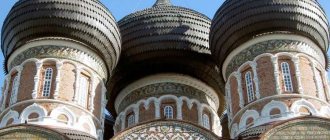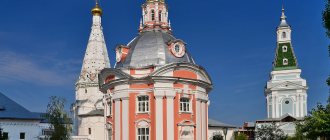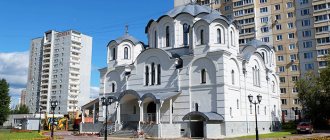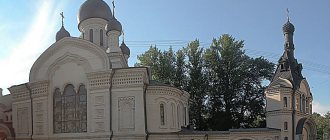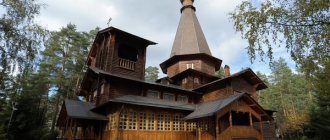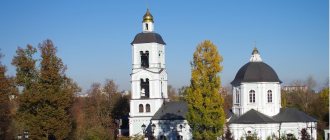The temples of the city of Pushkin are a real historical heritage and heritage of world culture. In the past, religion played a much larger role than today. Attending services was a daily, everyday event, and huge amounts of money were spent on the construction of churches. And the best architects, master painters and sculptors were invited for the imperial residence. In Tsarskoe Selo, cathedrals were built for visiting royal persons, public churches and regimental churches.
Here you can trace the entire history of church architecture from the end of the 18th to the beginning of the 20th century. Political thought was also reflected in the appearance of large cathedrals: many churches are stylized as Byzantine, and one of the cathedrals even bears the name St. Sophia. Here the centuries-old dream of recapturing Constantinople from the Ottomans and returning it to the fold of Orthodoxy was reflected.
In the appearance of the temples one can trace pseudo-Byzantine, Northern Russian, and classical architectural styles. People of various religions served at the court, and in addition to Orthodox churches in Pushkin you can see Lutheran and Catholic churches. These temples introduced the traditions of Western European architecture into the appearance of the city.
Znamenskaya Church
The very first temple built in Tsarskoe Selo is the Church of the Sign. Its construction began back in 1710, together with the first buildings of the Catherine Palace, when the Sarskaya Manor (then name of the settlement) was presented by the emperor to his wife Catherine. In 1714, along with the growing number of parishioners, it was decided to build a separate church. And by 1724 a new expansion of the building was made.
At first the temple was wooden, but a fire in 1728 destroyed the structure. To prevent this from happening again, they decided to rebuild the church from stone. Construction of the new building dragged on for 13 years. By this time, Elizabeth had ascended the throne and ordered the new church to be named Znamenskaya, in honor of the icon she revered, transferred to this temple.
The Znamenskaya Church is considered the oldest building in Pushkin and the first built of stone.
History of the Znamensky Temple
A century and a half later, in the 1890s, during the reign of the peacemaker Emperor Alexander III, the Znamenskaya Church in Pushkin was significantly rebuilt under the direction of the Italian-born architect Silvio Amvrosievich Danini. In memory of the miraculous rescue of the august family during the 1888 train accident, many churches and chapels were built near the Borki station in Russia.
Having started work on the Znamensky Church, in 1891 Danini first removed the two side aisles of the temple due to its small size. A special side room with a separate entrance was added to the main volume of the temple - “the rest of the highest persons.” As a result, the temple, without its former chapels, acquired a rectangular shape in plan, and its inside was lined with artificial marble. Electric lighting was installed in the temple.
The twentieth century, especially its beginning, became a time of relative peace for the Znamenskaya Church.
Church of the Resurrection of Christ in the Catherine Palace
In the palace itself, another house church was built in 1740. The opening was attended by the reigning empress, the heir to the throne and his wife (the future Catherine II). The church was erected according to the plan for the reconstruction of the Catherine Palace.
The new temple is adjacent to the palace. You can enter it through the front rooms. The façade of the church, decorated by the famous Rastrelli, is decorated with a double colonnade: massive columns up to the second floor and lightweight ones on level 3-4. The church is decorated with angels and cherubs. The whole thing is crowned by a roof with five domes.
The inside of the temple is decorated in the Rococo style, with an abundance of artistic elements. The blue walls contrast strongly with the gold of the icons and the altar. The altar contained an altar canopy on eight columns and a six-tiered iconostasis.
After the revolution there was a museum here. The building was heavily damaged during the Great Patriotic War. The temple was looted by the invaders, and the roof was destroyed by a shell. Partial restoration was carried out in 1963, again rebuilding the dome, but the interior and decoration still need restoration.
Kazan Church
Under Catherine II, another outstanding church was built in Tsarskoe Selo - the Kazan Icon of the Mother of God. The small building was built in a classical style. Its bell tower is a copy of the bell tower in Lomello (Italy). This temple is located in the cemetery of the same name. The cemetery itself is also quite interesting - many of the graves have small chapels and magnificent monuments built on them. In the temple itself there is the tomb of Count Lansky, Catherine’s favorite, and his relatives.
After the revolution, the temple was given over to a warehouse. Some of the utensils and slabs were donated to museums. Today, the temple has been partially restored and services are held there.
Church of the Icon of the Mother of God “The Sign” in Tsarskoe Selo
Initial story
St. Petersburg. Znamenskaya Church. Photo from the 1900s from the website of the St. Petersburg Metropolitanate
To the south of St. Petersburg is the small town of Pushkin, which until 1918 was called Tsarskoe Selo, and the brightest pages of its history are associated with this name. Until the 16th century, these lands belonged to Veliky Novgorod, then the Swedes began to own them. On the site of the future imperial residences there was a Sarskaya manor, or in Finnish Saari-mojs, which means “elevated or upper manor.” The name is quite true: the area is located much higher than St. Petersburg.
In 1710, Peter I donated the manor, along with the surrounding lands, to his wife Ekaterina Alekseevna. For the empress, they first built a wooden two-story palace, which housed a “campaign, or cross” church, and in 1717 they began to build a stone palace. Even earlier, in 1714, next to the palace, “on the northern side of the so-called Big Birches, a few fathoms east of the present Znamenskaya Church,” as M.I. writes. Pylyaev, the first church was built for the population of the manor in honor of the Dormition of the Blessed Virgin Mary. The same Pylyaev O.
Since 1725, the village began to bear the name Tsarskoye, although you can find documents in which it is also called Blagoveshchensky. This second name is associated with the construction of a new temple.
The population of the village gradually grew, and already in 1717 the highest order was given to rebuild the cramped Assumption Church. In 1724, a new church was erected - the Annunciation of the Blessed Virgin Mary. It was wooden on a stone foundation. Its solemn consecration on August 6 of the same year was attended by two archimandrites and several priests, court singers sang, and the celebration was accompanied by cannon fire. The Annunciation Church did not stand for long; it burned down from a lightning strike on June 24, 1728.
Znamenskaya Church
Catherine I bequeathed Tsarskoe Selo to her daughter Princess Elizabeth. Elizaveta Petrovna loved this residence. “In her young years,” writes Pylyaev, “the crown princess... listened to matins, mass and vespers in church every day, read spiritual books at home, and sometimes went out into the field to enjoy falconry.” Her love for Tsarsky was enormous. As soon as she ascended the throne, she instructed the architect Mikhail Zemtsov to draw up a project for enlarging and rebuilding the old Catherine Palace. Architect I.Ya. was invited to build a new church on the site of the old one, which burned down when Elizabeth was crown princess. Form. Construction of the temple took place from 1734 to 1747.
To this day, the church has retained the features of the early, “Petrine” Baroque. Its western facade is decorated with a small four-column portico with a balcony. The low dome and openwork bell tower with a spire give the church lightness and grace.
The consecration of the temple took place very solemnly. An ancient family icon of the House of Romanov was delivered from St. Petersburg in a religious procession, in which the Holy Synod, the entire court, and the Empress herself participated. The Empress walked the whole way and even helped carry her.
The miraculous icon of the Mother of God “The Sign” of Tsarskoye Selo
An authentic photograph of the miraculous Tsarskoye Selo Icon of the Mother of God “The Sign”. Photo from the 1910s. from the website of the St. Petersburg Metropolitanate
Little is known about the history of this image before the 17th century. It was most likely given as a gift by Athanasius Patelarius, Patriarch of Constantinople, to Tsar Alexei Mikhailovich. Peter I transferred the image to St. Petersburg and valued it no less than the Kazan Icon of the Mother of God. The image of the “Sign” was inherited by Empress Elizabeth Petrovna, who especially revered it. On the night before the coup that brought her to the throne, the princess prayed fervently before him.
The decree on the accession of Elizabeth Petrovna to the throne was promulgated on November 27, 1741 - the day of the celebration of the icon “The Sign”.
Elizaveta Petrovna had a special reverence for the shrine and, wanting to express her respect to it, having completed the construction of the church in Tsarskoe Selo, she ordered it to be called Znamenskaya.
The icon was placed in the iconostasis on top of the image of the Last Supper, above the royal doors. Elizabeth decorated it with a golden robe and stones, and ordered icons of the righteous saints Zacharias and Elizabeth, Saint Alexis, the man of God, and the Apostle Peter to be written in the margins. Later, in 1859, the faces of St. Nicholas and the Martyr Alexandra were added to the margins - in memory of Nicholas I and Alexandra Feodorovna.
In 1745, the iconostasis from the Trinity Cathedral on the Petrograd side was delivered to the church.
Over the years, the modest manor turned into a brilliant country residence of Russian autocrats, one of the most beautiful palace and park ensembles in Europe. The Znamenskaya Church was a precious decoration of this place. Both Empress Elizaveta Petrovna and her nephew's wife, the future Empress Catherine II, often prayed in it and donated a lot to it.
Elizaveta Petrovna spent almost the entire year of 1761, the last year of her reign, in Tsarskoe Selo. Every day she walked from the palace to the parish Church of the Sign. On September 8, the feast of the Nativity of the Blessed Virgin Mary, during the service she felt ill, went outside and fell unconscious on the grass. She was brought to consciousness and carried to the palace. The empress lost her tongue; she could not speak for several days. In December, Elizaveta Petrovna died.
Her great-grandson, Emperor Alexander I, gave the wing of the palace closest to the church to a new higher educational institution - the Tsarskoye Selo Lyceum, in which the offspring of the best Russian noble families were to be educated. The lyceum enrolled 30 students and opened in 1811.
It is known that lyceum students went to the Church of the Sign on holidays and on Sundays (on weekdays they visited the palace Church of the Resurrection).
Some Pushkin scholars believe that it is about the Tsarskoye Selo icon “The Sign” that is spoken of in the poem by A.S. Pushkin in 1830 “At the beginning of my life I remember school...” - the deepest of all his poetic memories of the Lyceum.
The rector of the court church in Tsarskoe Selo, Master John Tsviev, wrote about the icon in 1865: “Many claim, and we ourselves have noticed, that the face of the Mother of God at one time makes different impressions on those praying: sometimes it seems bright and touching, then suddenly it “darks” and takes on a stern look, even if you were standing in the same place.” The image is characterized by “angelic kindness in the eyes and at the same time, as it were, severity, simplicity of forms and at the same time their beauty and grace.”
The icon of the Sign was located above the royal doors until 1831. Only once was it removed and taken out of the church - precisely on May 12, 1820. That day, a fire broke out in the Tsarskoye Selo Palace, threatening neighboring buildings and the church. They say that when the icon was taken out of the temple and turned towards the place of the fire, Emperor Alexander I exclaimed out loud:
- Mother of God, save my house!
Instantly, the wind that was directing the flames towards the church and neighboring buildings, as if obeying an invisible force, changed, and the fire quickly died out.
In 1831, cholera raged throughout almost all of Russia, and St. Petersburg was not spared. Residents of Tsarskoye Selo gathered at the icon of the Sign, carried it to the middle of the temple and served a solemn prayer service in front of it. Then the icon was carried around the entire city with singing and prayers. Cholera passed Tsarskoe Selo. In memory of this good deed of the Mother of God, the residents asked for the highest permission to move the icon from the iconostasis to the inside of the church - it was placed on the right side. An annual religious procession was also established on July 5th.
In 1848, another cholera epidemic swept through Russia, but Tsarskoe Selo again escaped this disaster. In gratitude, in 1849 the icon was covered with a precious embroidered chasuble with many diamonds, pearls, turquoise, amethysts, sapphires, emeralds and opals. The stones that did not fit on the robe were used to create a precious crown. The robe was embroidered by a pious maiden, a resident of Tsarskoe Selo, Maria Davydova, to whom the Mother of God appeared in a dream and showed her exactly what and how to do. It happened that Davydova did not have enough suitable stones, and then donors unexpectedly appeared with the necessary jewelry. The largest stone on the frame was a large heart-shaped topaz, on the edges of which the dates 1831 and 1848 were carved - the years of the miraculous deliverance of Tsarskoe Selo from cholera. At the bottom of the icon, on a heart-shaped gold plate, were engraved the words: “For salvation from the epidemic, accept, O Merciful Lady, Patroness of the city of Tsarskoye Selo, these pearls, like tears of gratitude, watering Your most pure robe, from Your zealous servants, and henceforth have mercy on us.”
The precious robe was lost during the nationalization of church values in the first years after the revolution.
One cannot pass over in silence another event in which the saving power of the holy icon was manifested and the deep faith of the reigning family in the miraculousness of this shrine was reflected. On June 16, 1863, at 2 o'clock in the afternoon, a strong fire began in the Tsarskoye Selo Palace, which was first noticed by Emperor Alexander II. Despite all the measures taken, the flames quickly spread, destroying everything along the way that could serve as food for it. Having burned part of the palace, the fire almost instantly engulfed the domes and crosses of the palace cathedral and penetrated inside it. Then Emperor Alexander II and Empress Maria Alexandrovna wished to remove the miraculous icon from the Znamenskaya Church. The crowned owners came out to meet the icon and kissed it, the icon was carried around the burning palace, and the fire stopped almost instantly.
Tsar's architect
Silvio (Valentin Amvrosievich) Danini with his wife
The Church of the Sign was restored and rebuilt several times. Under Catherine, a balcony was added to the western side and four porches were built; in 1784, the church was surrounded by iron bars with stone pillars, and warm wooden chapels were built. Before the revolution, the temple was restored by the architect Silvio Danini.
The Danini family comes from Mantua, in Northern Italy. Silvio, the son of the great singer and virtuoso, poet and writer Ambrogio Danini, was born in Kharkov in 1867. In 1892, he graduated from the Academy of Arts with the title of “class artist of the 1st degree.” Soon he was invited as an assistant to the famous architect Alexander Krasovsky, who was tasked with rebuilding the northwestern wing of the Winter Palace for the future Emperor Nicholas II. This first order and its successful completion opened the way for Danini to a brilliant career. It came into the personal possession of Emperor Nicholas II. He was tasked with rebuilding the Church of the Sign, located not far from the Catherine Palace.
In Tsarskoe Selo, Danini built many more: palaces, schools, mansions, churches, power plants, hospitals, shelters... His buildings are characterized by a combination of neo-romanticism and modernism with motifs of medieval architecture.
Silvio Danini died in Leningrad on January 11, 1942, during the siege. His descendants now serve in one of the churches in St. Petersburg.
History of the temple in the 20th
century
Before the start of the Great Patriotic War, the Znamenskaya Church remained the only one functioning in the city of Pushkin; even during the occupation, services took place there. Before the retreat, the Nazis stole most of the icons and church utensils from the church, but fortunately, the church as a whole was not damaged; the iconostasis was even preserved inside, albeit without icons.
In August 1942, the church ceased to be active. Empty, looted, it was used either as a warehouse or as a restoration workshop.
The Nazis took away the Znamenskaya Icon along with other museum valuables of the Catherine Palace. But the miraculous image returned to Russia and since 1946 has been in the Church of the Holy Apostle and Evangelist John the Theologian of St. Petersburg Theological Schools. In the Znamensky Church of Pushkin there is now a copy of the miraculous icon.
In 1960–1962 the church was restored. During the restoration, archival materials, plans and surviving drawings of the architect V.I. were used. Neelova. The original architectural appearance of the temple was recreated, all later additions were removed, the bell tower spire and dome were given their original shape. Until the 1990s, the church housed the office of the workshop of the Restorer association, which was under the jurisdiction of the Catherine Palace Museum.
In 1991, the temple building was returned to the believers, and on December 10, 1991, on the day of the Icon of the Mother of God “The Sign,” the church was opened for worship. The church is assigned to the St. Sophia Cathedral in Pushkin.
An engineering survey in 1992 showed that the building was in disrepair. There were terrible cracks in the walls up to 20 cm wide. The church literally stood on the ground, and it was necessary to strengthen the foundation, saving the building from the destructive dampness. The interior decoration was damaged, the dome was damaged, the stoves, parquet floors, and iconostasis were lost.
Today, the restoration of the ancient Tsarskoye Selo church has been completed. The restoration was carried out with public funds. The building is on the balance sheet of KGIOP, which monitored the precise restoration of all details of decoration and decoration. The roof was repaired, the spire and the weather vane on the spire were again gilded. For the 300th anniversary of St. Petersburg, the porcelain iconostasis was recreated. Now there are many new icons in the temple. Recently, the icon of the royal martyrs has been greatly revered here. In 2003, the renovated temple shone again, as in the times of Pushkin and Karamzin, and today the bell ringing of the Znamenskaya Church every hour announces the revived Tsarskoye Selo shrine.
Saint Sophia Cathedral
Perhaps the main temple of Pushkin is the St. Sophia Cathedral. It was built during the reign of Catherine II who, as already mentioned, dreamed of conquering Constantinople. This was not just a desire; medals had already been cast for the upcoming war, and Catherine’s grandson Konstantin was to become the ruler of the new empire. The cities annexed at that time were given Greek names (Sevastopol, Simferopol). In honor of the future conquest, the Empress ordered the construction of a worthy cathedral in Tsarskoe Selo.
Construction began in the summer of 1782 under the direction of Cameron. The construction of the stone temple took six years. The architect's task was to give the building the features of the famous Balkan prototype. The first thing that catches your eye when looking at the temple is its dome floating in the center. The similarity is emphasized by antique columns in black and red tones. However, there are also differences from the original. The influence of Russian classicism is clearly felt in the Pushkin Cathedral.
The conquest of Constantinople never took place, but the cathedral remained a military symbol - in 1817 it became the regimental church of the Life Guards Hussar Regiment. Soon, another throne was added to the cathedral in honor of the Great Martyr Catherine. In 1832, services were also held here for the cuirassier regiment (who did not yet have their own church).
In 1849, a new reconstruction was carried out, during which the second chapel was re-dedicated in honor of Constantine and Helena. An additional chapel was also built, dedicated in honor of Alexander Nevsky. A chapel of Seraphim of Sarov was built in the garden near the temple.
After the revolution, ecclesiastical use of the cathedral ceased. Somewhat ironically, the military cathedral was given over to military needs - in 1934 a military warehouse was placed here. But this use of the cathedral was short-lived; in 1960 a garage cooperative was located here. Services here resumed only in 1989. And the next year, a bust of Alexander Nevsky was installed nearby. The interior of the temple never returned to its historical form. Everything inside is quite ascetic (although it was simple here before). Altars and iconostases have been restored. The cathedral has also regained its military-religious significance: here today they take the oath and organize prayer services for the military.
The practice of building regimental churches was widespread in Russia in the 18th-20th centuries. Each garrison, school or corps created its own temple. For services in such churches, there was a special Military and Naval clergy (the head of which could promote and dismiss his subordinates without asking the Synod). There are several regimental cathedrals in Pushkin.
Current state[edit]
The church community was formed in 1988. After which Metropolitan Alexy (Ridiger) turned to the Pushkin district executive committee with a request to register the community and transfer the cathedral to it. On March 13, 1988, the decision to transfer the temple was made.
On June 8, 1989, on the patronal feast of the Ascension of the Lord, the first liturgy was celebrated by Archpriest Gennady Zverev. The restoration of the cathedral began with its bell tower, which was restored by April 1991.
On March 20, 1995, St. Sophia Cathedral was included in the list of architectural monuments of federal significance.
In May 1998, the “Vyatka Handicraft Workshops” produced and installed new iconostases, which are copies of the pre-revolutionary ones. After the iconostases were kept in the temple, all carved parts were gilded.
On May 17, 1999, the complete consecration of the temple took place.
the monument to St. Alexander Nevsky , erected north of the cathedral, was consecrated
the work of the sculptor V. G. Kozenyuk. The monument was erected for the 750th anniversary of the Battle of the Neva in 1240, on the initiative and with the participation of the Kolpino art and design cooperative “Zodchiy”.
The monument is part of a project for an equestrian statue that the sculptor submitted to the competition for a monument to the Grand Duke in 1990 and received second prize. This is a bronze bust on a granite pedestal, above which a metal canopy arch is erected. On the ring in the arch, “1240-1990” is written in cast characters; on the bust - “Alexander Nevsky”. The height of the bust is 0.8 m, the height of the pedestal is 3.8 m.
In 2003, a memorial sign about His Majesty’s Life Guards Hussar Regiment
. Established in accordance with the program of the Ministry of Defense of the Russian Federation “St. Petersburg - the military-scientific and military-industrial center of the country” with the support of the administration of St. Petersburg.
The design of the sign was developed by the architects of the Darcy architectural studio together with military architecture specialists from the St. Petersburg Military Engineering and Technical University (V.N. Filippov, V.V. Smolin, V.N. Golovkin, E.E. Lavrushin, V. I. Mukhin). Manufactured by the Baltic Construction Company.
On September 29, 2015, the monument to the prince of the imperial blood Oleg Konstantinovich, who died in 1914,
, who served in the ranks of the Life Guards of His Majesty's Hussar Regiment. The installation of the monument took place on the initiative of the Ludwig Nobel Foundation. The monument was made under the leadership of Yaroslav Borodin, a member of the Moscow Union of Artists, based on a model created in 1915 by sculptor, academician V.V. Lishev.
Fedorovsky Sovereign Cathedral
An outstanding example of such churches is the Feodorovsky Sovereign Cathedral. It was erected for the Consolidated Guard Regiment and the Convoy of the reigning family. The cathedral stands in the Fedorovsky town - barracks next to the Alexander Palace.
The guard regiment did not have its own temple for a long time, which was regularly reported to the king. In addition, the king’s residence did not have its own temple, which created some inconvenience for the crowned family itself. At the beginning of the 20th century, the monarch heeded the requests of his soldiers.
Construction of the cathedral began in 1909 under the supervision of the architect Pokrovskorgo. The Annunciation Cathedral in Moscow was taken as a model. This is a cathedral stylized as traditional Russian churches with one dome around which there are galleries. The appearance of the temple is quite simple and ascetic, which gives the church a strict and serious appearance. The interior decoration immediately amazed with its luxury: a large and rich iconostasis, magnificent painting of the walls and dome. Initially, there were supposed to be two chapels, but then an underground temple (cave church) was added, consecrated in honor of Seraphim of Sarov.
Only representatives of the Romanov dynasty and the Tsar’s guards and their families had the right to visit the cathedral. For major celebrations, persons favored by the king were sent invitations to the cathedral (as a sign of special honor). The cave church was used only for the emperor's family.
Church of St. Sergius of Radonezh
Another temple built for the needs of the military is the Temple of Sergius of Radonezh. This saint once blessed Dmitry Donskoy for battle and is especially revered by soldiers. The temple was built for the 2nd Infantry Battalion. The first temple was built in 1557 from wood. Then the church building came into use by the Life Guards. Icons revered by the military that accompanied them on campaigns were kept here. For field services, a folding iconostasis was used.
The 2nd battalion was built a new building on the Sofia parade ground, also named after Sergius of Radonezh. At the beginning of the last century, the altar and bell tower were completed in the church.
After the revolution, the temple was closed and was not used for a long time. The church building was seriously damaged during the war. All that was left of it were ruins. In 1972, driving courses were located in the newly rebuilt building. This is how the temple was used until 2009, when the question of returning the church building was raised. Now the temple has been restored and re-consecrated. Church services are held here.
Interesting Facts
Within the walls of the St. Sophia Cathedral, the hussars of the Life Guards not only prayed, but also preserved standards, as well as numerous awards for military exploits. The names of the officers who heroically died in battle were carved there - on marble boards.
One day, an interesting find was discovered in the temple: during the arrangement of the basements there (they wanted to place ovens in them), the diggers found a silver and gilded spatula and a hammer. They bore the monogram of Empress Catherine and the inscription “Charles Cameron – Architect.”
In Soviet times, the St. Sophia Cathedral was destined to be not only a warehouse: it also served as a place for recycling industrial waste, and a garage cooperative, and even a swampy garbage dump.
Julian Church
A cuirassier regiment was based in Tsarskoe Selo for a long time. He arrived here in 1832. This was the first such regiment, dating back to the time of Peter I. Since then, cuirassiers have participated in all major wars of the empire and have glorified their name on the battlefields more than once. At one time, Nicholas I served in the ranks of this regiment.
The regiment's servants satisfied their religious needs for a long time in one of the aisles of the St. Sophia Cathedral. However, this led to overcrowding and created unnecessary crowds on holidays. At the end of the 19th century, it was decided to build a separate church. The construction of the temple was timed to coincide with the marriage of Nicholas II to Alexandra Fedorovna. The site was consecrated in 1899.
There are two chapels, one of which is underground. A feature of the temple that distinguishes it from other churches is the play of light. Here its main source is the altar. The iconostasis stands in front of a large arched window. The iconostasis itself is extremely transparent, which makes it possible for light to pass inside the church. For even greater illumination, the temple is oriented to the south.
In the church, the regalia of the regiment were kept in eternal storage: its banners, awards, trophies, documents of fallen officers, chief's uniforms and the cuirass of Nicholas I. In 2006, a comprehensive restoration of the church began, which continues to this day.
Attractions
In the northern part of the cathedral, visitors will be greeted by the bronze-granite Alexander Nevsky. The initiators of the appearance of the monument to the saint were Kolpino architects: they glorified the Russian victory in the Battle of the Neva on the occasion of its 750th anniversary. In pursuance of one of the programs of the Ministry of Defense of the Russian Federation, a memorial sign was installed and consecrated on the territory of the St. Sophia Cathedral, reminiscent of the fact that the temple was a place of worship for the Life Guards Hussars of His Majesty's regiment. One of the cathedral's attractions is the parish school, as well as the church and small church houses (the latter houses the reception room of the rector of the cathedral). A pavilion was erected not far from the reception: lectures, charity events, and concerts are often held in its building. Since 1996, Archpriest Alexy Makhonin served in the St. Sophia Cathedral. After his death, his final resting place was a grave in the eastern part of the temple grounds.
Sorrow Church
Women's military service was not accepted in the Russian Empire, but everyone could help the Motherland as sisters of mercy. Women's civil organizations also had their own temples. In the same year as the Julian Church in Tsarskoe Selo, the Women's Committee of the Red Cross was created. At first they rented a mansion on Gegelevskaya, but in 1905 the Tsarina took them under her wing. In 1905, when the imperial family moved to Tsarskoye Selo, the empress took the nurses under her wing. Three years later, the committee received a new building at its disposal, which housed a hospital and a dormitory for nurses. In 1912, a new stone building was built where the Church of All Who Sorrow was located. The old building was completely turned over to a hospital. The new temple housed many sacred ancient icons. The walls were painted by Pashkov based on Vasnetsov’s sketches.
By the beginning of the First World War, a hospital for wounded soldiers was located here. It also provided training for all willing women in medical specialties. The Empress and her daughters also trained and worked here.
Panteleimon Church
On the territory of the city hospital you can find another Orthodox church. This is Panteleimon Church. It is a small one-story building with one dome rising above the yellow walls. The temple is the heir of the hospital church, which worked at the city hospital in Sofia (a neighboring town). When this city became part of Tsarskoye Selo, the local church was moved here.
Initially, this temple was located outside the city on the road to Pavlovsk, but then the city grew in this direction. The church was built back in 1782. The Church of the Holy Great Martyr Panteleimon the Healer is an Orthodox church in the city of Pushkin on the territory of City Hospital No. 38 named after N. A. Semashko.
Catherine's Cathedral
One of the main churches in Pushkin is the Catherine Cathedral. This is the largest temple in Tsarskoe Selo. It was supposed to be the main city temple of the city. Up to 2 thousand parishioners can fit here at the same time.
It was built in 1840 by personal order of Nicholas I. It was a stone church. The cathedral building was built in the style of old Russian churches. Byzantine notes in the architecture are clearly noticeable here. The building reaches a height of 50 meters. The top of the temple is decorated with five domes with a dark gold coating, emphasizing the crosses placed on them. The main element of the cathedral walls are arches decorated with images of angels. On the east wall there is a large image of St. Catherine. The best craftsmen and artists were invited for interior decoration. The altar was like a throne. The iconostasis is carved, gilded, in 5 tiers.
Around the cathedral, immediately after its construction, a small park with twelve paths was laid out. Just three years after its opening, two hundred Dutch poplars were planted here. There was a school at the cathedral.
After the revolution, services in the temple continued until 1938, although they did not attract such a number of parishioners. The following year the temple was destroyed. A monument to Lenin was erected on the site of the temple.
In 2006, a decision was made to restore the temple. To recreate an authentic view of the cathedral, the Institute of the History of Material Culture of the Russian Academy of Sciences carried out excavations that discovered the foundation and some church utensils. The construction of the new building took two and a half years (from February 2007 to August 2009). The consecration of the temple took place in 2010. In the basement there is a museum of the Tsarskoye Selo deanery, dedicated to the churches of Pushkin.
Evangelical Lutheran Church
In connection with the opening of a lyceum in the city, where many teachers were Lutherans, the need arose for the emergence of a corresponding parish. For the needs of believers of this denomination, the first Lutheran church was built in Tsarskoye Selo in 1818.
First, a small temple made of wood was erected. On the site allocated for the church, schools were built for children from German families and immigrants from the Baltic states. There was a Protestant cemetery nearby.
However, the temple could not accommodate everyone. Due to the growing number of parishioners, a new stone church was built in 1865, which has come down to us. The church was built in English style. There is a feeling of upward striving throughout the form. The buttresses at the corners of the temple are clearly visible. The typical pointed arches are present and the roof ends in a long spire. The walls are made of bare red brick. The interior contrasts with the exterior of the church: one enters into a spacious white arched hall with a minimum of details.
After the revolution, services here continued until 1931, when the temple was closed and turned over to a hostel. ON THE 2nd floor was the red corner of the local repair shop. After the war, the country needed drivers and the building was given over to a driving school. In 1977 the church was transferred to the Finnish community and re-consecrated.
Roman Catholic Church of St. John the Baptist
People from all over Europe served in the residence of the emperors and, accordingly, they adhered to different religions. Along with the opening of the Lutheran parish in Tsarskoe Selo, the Catholic Church was founded.
At first, services were held in the private home of O.O. Mezonyaeva. However, as the number of parishioners grew, a decision was made to expand the parish. By personal order of the tsar, a plot of land on Hospital Street was allocated for the parish. Also, the monarch doubled the amount of donations.
Construction of the building began in 1825 and lasted a year. The building was built in the style of classicism. The main entrance is an “antique” portico with a colonnade. Elegant white walls without unnecessary elements are crowned with a high elongated dome. Initially it was a church with one side-altar. Then they added two more. A metal cross with particles of the Holy Cross was kept in the church.
After the revolution, the temple operated until 1938. The building was given over to a sports complex, and the burial site under the cathedral was eliminated. During the war, the temple was badly damaged by shells and was restored only in the 60s. In the summer of 2006, the church was transferred to the Catholic Church.
Znamensky Temple inside
After the return of the temple to believers in 1991, it was decided to restore the interiors of the building as they looked during the reign of Emperor Alexander III. It was then that some of the walls of the temple were decorated with artificial marble from the inside.
Today, the interior of the Znamenskaya Church has a pale green or, rather, soft turquoise color scheme, in places with white edging. It blends seamlessly with the light brown tones of the parquet floors of the church.
The internal structure of the Church of the Sign of the Most Holy Mother of God consists of three naves: a central one and two side ones, which are significantly lower than the middle, since they have one floor.
The two-tiered central nave is quite spacious and quite bright, as it is illuminated by windows cut into the longitudinal walls. The current iconostasis of the Church of the Sign is made in the traditions of Russian Baroque and is an exact copy of the original one.
The iconostasis in the form of a screen partition 6.4 meters wide is lavishly decorated with skillful carvings. Important iconographic attributes of the carved decoration of the iconostasis are four festive images, enclosed in rounded gilded frames: “Annunciation of the Blessed Virgin Mary”, “Introduction into the Temple”, “Transfiguration of the Lord” and “Descent of the Holy Spirit”.
The only chandelier of the temple hangs under the arches of its central nave. Traditionally for Orthodox churches, it has a rich appearance, which has been updated during modern restorations.
An original detail of the interior space is a cast-iron staircase installed in the narthex to the left of the main entrance portal of the church. It was erected back in 1878 and leads to the choir, where until 1865 the altar of the St. Nicholas chapel was located. From there you can climb up to the bell tower.
The temple is warm even in winter thanks to the installed central heating and two powerful stoves, restored in our time.
Now the Znamensky Church of the former Tsarskoye Selo is assigned to the Cathedral of the Holy Great Martyr Catherine of the St. Petersburg Diocese of the Russian Orthodox Church.
Church of the Blessed Prince Igor of Chernigov
There are also recently built churches in Pushkin. The most noticeable of which is the Church-Chapel of the Blessed Prince Igor of Chernigov. It was built in 1988 in memory of the victims of the Nazis (on the site where the massacres took place). Initially they just wanted to erect a monument, however, at the suggestion of the church, they decided to erect a chapel. Money for construction was collected voluntarily.
Services in the new church began only in 2001. The building is a cruciform church with one dome. Here is a book with a list of names of victims of fascist executioners. All of them are remembered at services. Every year, flowers are laid at the temple in memory of the occupation of the city.
The new temple was named in honor of Igor of Chernigov, the Kyiv prince, who was forcibly tonsured a monk. This prince retired from politics and lived as a modest monk in a monastery. However, politics did not move away from him. The rebels of Kiev seized the former prince and brutally dealt with him. It is believed that with his death this saint atoned for the sin of civil strife.
After the revolution
During the harsh years of Soviet power, the temple survived, but was closed on October 10, 1934. A long period of oblivion began in the history of the temple. It was decided to transfer the building to the 32nd Mechanized Brigade, and the military very soon turned it into a warehouse, and the former cathedral square began to be used as a training ground for military equipment.
During the Great Patriotic War, the St. Sophia Church survived, but was significantly damaged. And after the liberation of Pushkin, the city authorities, instead of repairs, did not find anything better than to arrange a vast landfill near the Church of Sophia.

